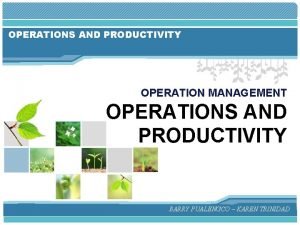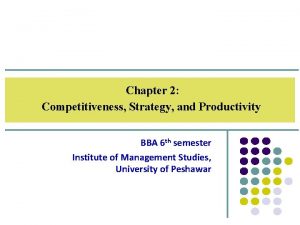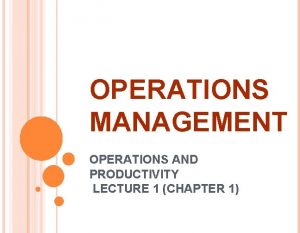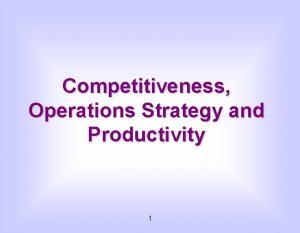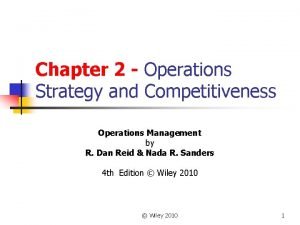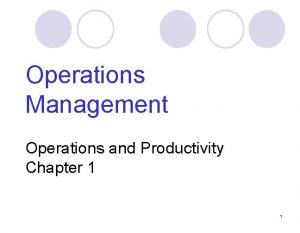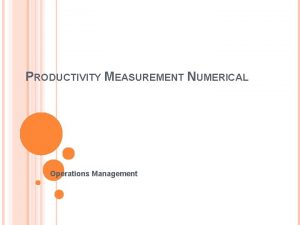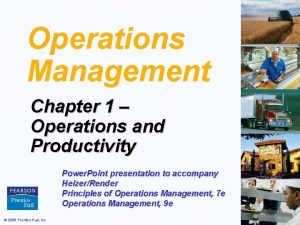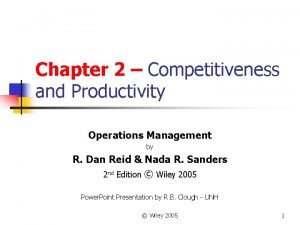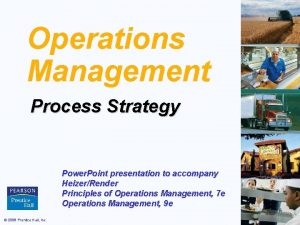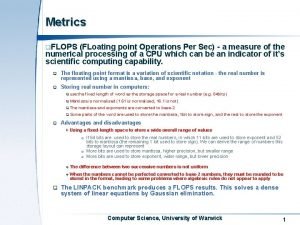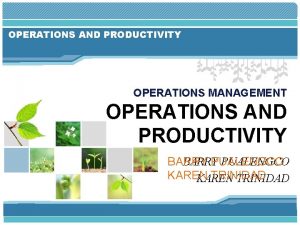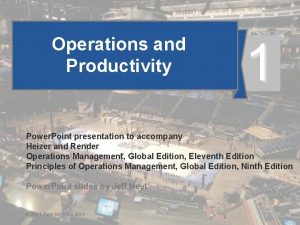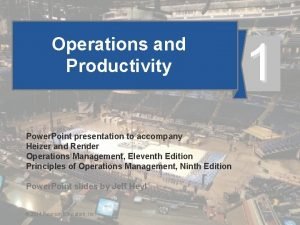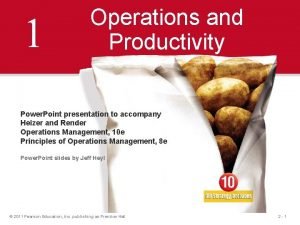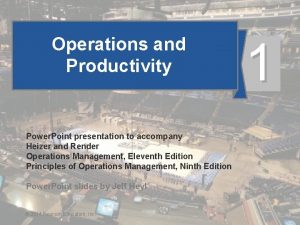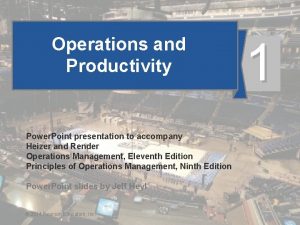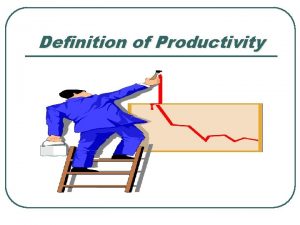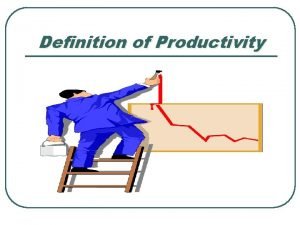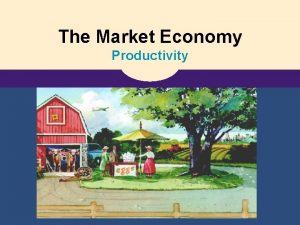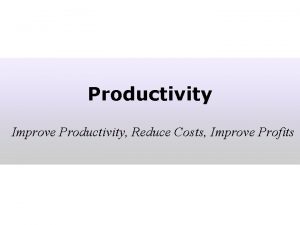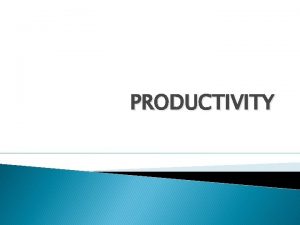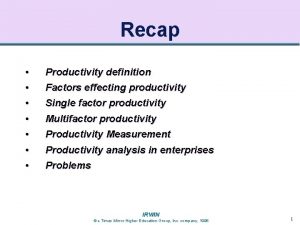1 Operations and Productivity Power Point presentation to



















- Slides: 19

1 Operations and Productivity Power. Point presentation to accompany Heizer and Render Operations Management, 10 e Principles of Operations Management, 8 e Power. Point slides by Jeff Heyl © 2011 Pearson Education, Inc. publishing as Prentice Hall 1 -1

Learning Objectives When you complete this chapter you should be able to: 1. Define operations management 2. Explain the distinction between goods and services 3. Explain the difference between production and productivity © 2011 Pearson Education, Inc. publishing as Prentice Hall 1 -2

Learning Objectives When you complete this chapter you should be able to: 4. Compute single-factor productivity 5. Compute multifactor productivity 6. Identify the critical variables in enhancing productivity © 2011 Pearson Education, Inc. publishing as Prentice Hall 1 -3

What Is Operations Management? Production is the creation of goods and services Operations management (OM) is the set of activities that create value in the form of goods and services by transforming inputs into outputs © 2011 Pearson Education, Inc. publishing as Prentice Hall 1 -4

Organizing to Produce Goods and Services u Essential functions: 1. 2. Marketing – generates demand Production/operations – creates the product 3. Finance/accounting – tracks how well the organization is doing, pays bills, collects the money © 2011 Pearson Education, Inc. publishing as Prentice Hall 1 -5

Organizational Charts Commercial Bank Operations Finance Marketing Teller Scheduling Check Clearing Collection Transaction processing Facilities design/layout Vault operations Maintenance Security Investments Security Real estate Loans Commercial Industrial Financial Personal Mortgage Accounting Auditing Trust Department Figure 1. 1(A) © 2011 Pearson Education, Inc. publishing as Prentice Hall 1 -6

Organizational Charts Airline Operations Ground support equipment Maintenance Ground Operations Facility maintenance Catering Flight Operations Crew scheduling Flying Communications Dispatching Management science Finance/ accounting Accounting Payables Receivables General Ledger Finance Cash control International exchange © 2011 Pearson Education, Inc. publishing as Prentice Hall Marketing Traffic administration Reservations Schedules Tariffs (pricing) Sales Advertising Figure 1. 1(B) 1 -7

Organizational Charts Manufacturing Operations Facilities Construction; maintenance Production and inventory control Scheduling; materials control Quality assurance and control Supply-chain management Manufacturing Tooling; fabrication; assembly Design Product development and design Detailed product specifications Industrial engineering Efficient use of machines, space, and personnel Finance/ accounting Disbursements/ credits Receivables Payables General ledger Funds Management Money market International exchange Capital requirements Stock issue Bond issue and recall Marketing Sales promotion Advertising Sales Market research Process analysis Development and installation of production tools and equipment © 2011 Pearson Education, Inc. publishing as Prentice Hall Figure 1. 1(C) 1 -8

Why Study OM? 1. OM is one of three major functions of any organization, we want to study how people organize themselves for productive enterprise 2. We want (and need) to know how goods and services are produced 3. We want to understand what operations managers do 4. OM is such a costly part of an organization © 2011 Pearson Education, Inc. publishing as Prentice Hall 1 -9

What Operations Managers Do Basic Management Functions u Planning u Organizing u Staffing u Leading u Controlling © 2011 Pearson Education, Inc. publishing as Prentice Hall 1 - 10

Ten Critical Decisions Ten Decision Areas 1. Design of goods and services 2. Managing quality 3. Process and capacity design 4. Location strategy 5. Layout strategy 6. Human resources and job design 7. Supply-chain management 8. Inventory, MRP, JIT 9. Scheduling 10. Maintenance © 2011 Pearson Education, Inc. publishing as Prentice Hall Chapter(s) 5 6, Supplement 6 7, Supplement 7 8 9 10 11, Supplement 11 12, 14, 16 13, 15 17 Table 1. 2 1 - 11

Where are the OM Jobs? u Technology/methods u Facilities/space utilization u Strategic issues u Response time u People/team development u Customer service u Quality u Cost reduction u Inventory reduction u Productivity improvement © 2011 Pearson Education, Inc. publishing as Prentice Hall 1 - 12

Opportunities Figure 1. 2 © 2011 Pearson Education, Inc. publishing as Prentice Hall 1 - 13

Characteristics of Goods u Tangible product u Consistent product definition u Production usually separate from consumption u Can be inventoried u Low customer interaction © 2011 Pearson Education, Inc. publishing as Prentice Hall 1 - 14

Characteristics of Service u Intangible product u Produced and consumed at same time u Often unique u High customer interaction u Inconsistent product definition u Often knowledge-based u Frequently dispersed © 2011 Pearson Education, Inc. publishing as Prentice Hall 1 - 15

Productivity Challenge Productivity is the ratio of outputs (goods and services) divided by the inputs (resources such as labor and capital) The objective is to improve productivity! Important Note! Production is a measure of output only and not a measure of efficiency © 2011 Pearson Education, Inc. publishing as Prentice Hall 1 - 16

Productivity = Units produced Input used u Measure of process improvement u Represents output relative to input u Only through productivity increases can our standard of living improve © 2011 Pearson Education, Inc. publishing as Prentice Hall 1 - 17

Productivity Calculations Labor Productivity Units produced Productivity = = Labor-hours used 1, 000 250 = 4 units/labor-hour One resource input single-factor productivity © 2011 Pearson Education, Inc. publishing as Prentice Hall 1 - 18

Multi-Factor Productivity Output Productivity = Labor + Material + Energy + Capital + Miscellaneous u Also known as total factor productivity u Output and inputs are often expressed in dollars Multiple resource inputs multi-factor productivity © 2011 Pearson Education, Inc. publishing as Prentice Hall 1 - 19
 Productivity in operations management
Productivity in operations management Labor productivity example
Labor productivity example Operations management productivity problems
Operations management productivity problems Productivity and competitiveness in operations management
Productivity and competitiveness in operations management Productivity and competitiveness in operations management
Productivity and competitiveness in operations management Operation and productivity chapter 1
Operation and productivity chapter 1 Multifactor productivity in operations management
Multifactor productivity in operations management Productivity definition in operations management
Productivity definition in operations management Productivity definition in operations management
Productivity definition in operations management Hindi presentation topics
Hindi presentation topics Power point presentation design west vancouver
Power point presentation design west vancouver Triangle of power
Triangle of power Power bi power point
Power bi power point Point point power
Point point power Vertex presentation and cephalic presentation
Vertex presentation and cephalic presentation Vertex presentation and cephalic presentation
Vertex presentation and cephalic presentation Operations management process strategy
Operations management process strategy Disadvantages of hub and spoke model
Disadvantages of hub and spoke model Bit4bytes
Bit4bytes Fractal image
Fractal image
